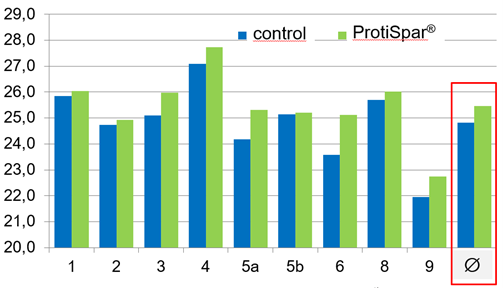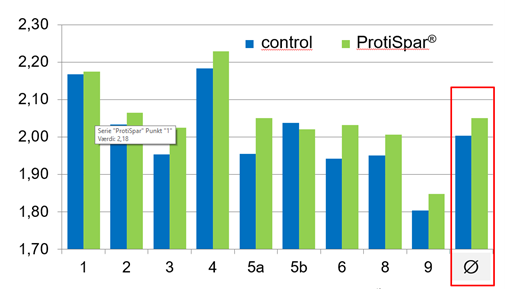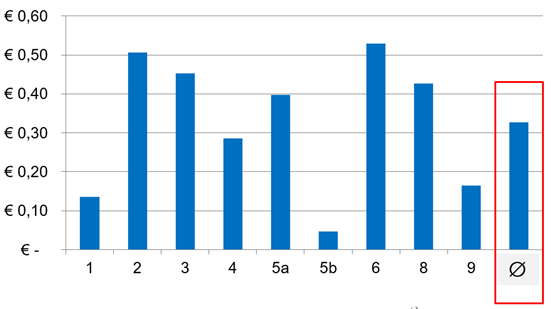Protispar - alternative and effective
This makes therefore ProtiSpar a very interesting additive - both in organic and non-GM feeding, but also in relation to the industry goal of reducing the crude protein distribution to below 17% for the Danish cattle sector.
ProtiSpar is a patented combination of essential oils that have been carefully selected for their synergistic effect on particularly protein efficiency. ProtiSpar is active in the rumen, where the ammonium hyperproducing bacteria, so-called HAP bacteria, are inhibited. This reduces the degradation of amino acids to nitrate in the rumen by up to 25%. This means, in addition to a significantly lower content of ammonia in the rumen, that the rumen's pH level can be maintained higher, which is better for the rumen's beneficial microorganisms. In this way, the added crude protein is better utilized to form more AAT, and the excretion of urea in both milk and urine is reduced. Popularly speaking, one can say that the amino acids obtain the desired function as AAT in the gut instead of being metabolized directly in the rumen by the bacteria. In addition to an increased amount of amino acid to the gut, it also means that the amount of ammonium to the liver is reduced just as the emission of ammonia to the environment is reduced.
ProtiSpar is a product with over 10 years on the German and Dutch market for feed additives and is therefore a well-proven and documented product.
Figures 1 and 2 show the results from a herd test conducted in the Netherlands in 2012 on nine herds, where ProtiSpar was added for a period of four to six weeks, with control periods before and after every three to five weeks.
For the first six herds, the feed rations were consisting of a roughage distribution of approx. 60% grass and 40% corn. For herd 8 the distribution was 40% grass and 60% corn and for herd 9, the distribution was 50% grass and 50% corn.
In all herds, the proportion of supplementary protein in the form of various soy / rapeseed compounds was reduced by a quarter to a half kilo in the rations and instead 20 g of ProtiSpar was added.

Figure 1: Kg of milk when adding ProtiSpar with control period before and after addition.
Herd testing of ProtiSpar Car Dronten University, 2012

Figure 2: Kg milk fat + protein when adding ProtiSpar with control period before and after addition.
Herd testing of ProtiSpar Car Dronten University, 2012
As can be seen from figures 1 and 2, the milk yield on average for all herds was higher during the period with ProtiSpar added, and only herd 5b experienced a small decrease in yield.
If these results consequently are compared with the feeding cost, the profit by adding ProtiSpar is on average 0.32 euros per cow pr. day, as seen in figure 3 below.

Figure 3: Income minus feeding cost when adding ProtiSpar.
Herd testing of ProtiSpar, Car Dronten University, 2012
For all herds, it was thus a positive calculation, including herd 5b, despite the small drop in performance they actually experienced here.
| ProtiSpar can thus improve the economy by increasing the protein utilization. At the same time, it is energy-saving for the cow to convert less ammonium in the liver to urea, which not only increases the feed efficiency, but also reduces the evaporation of ammonia from urine in the cow unit in favour of the environment.
ProtiSpar is added with 20 g per cow per day. It is possible to add both to the mineral compound and to the concentrate feed. This can cut down the protein allocation in the equivalent of 0.5 kg of soybean meal. ProtiSpar can be used in both conventional and organic production and is thus also approved for non-GM production. |

